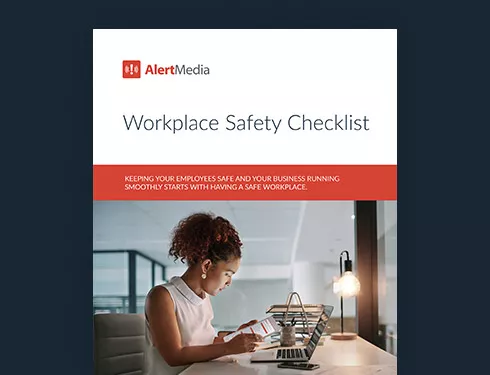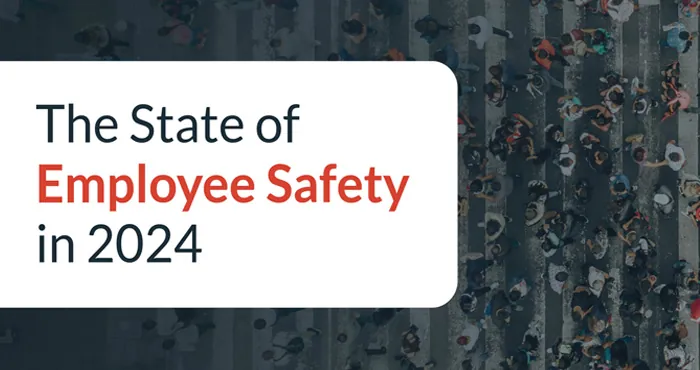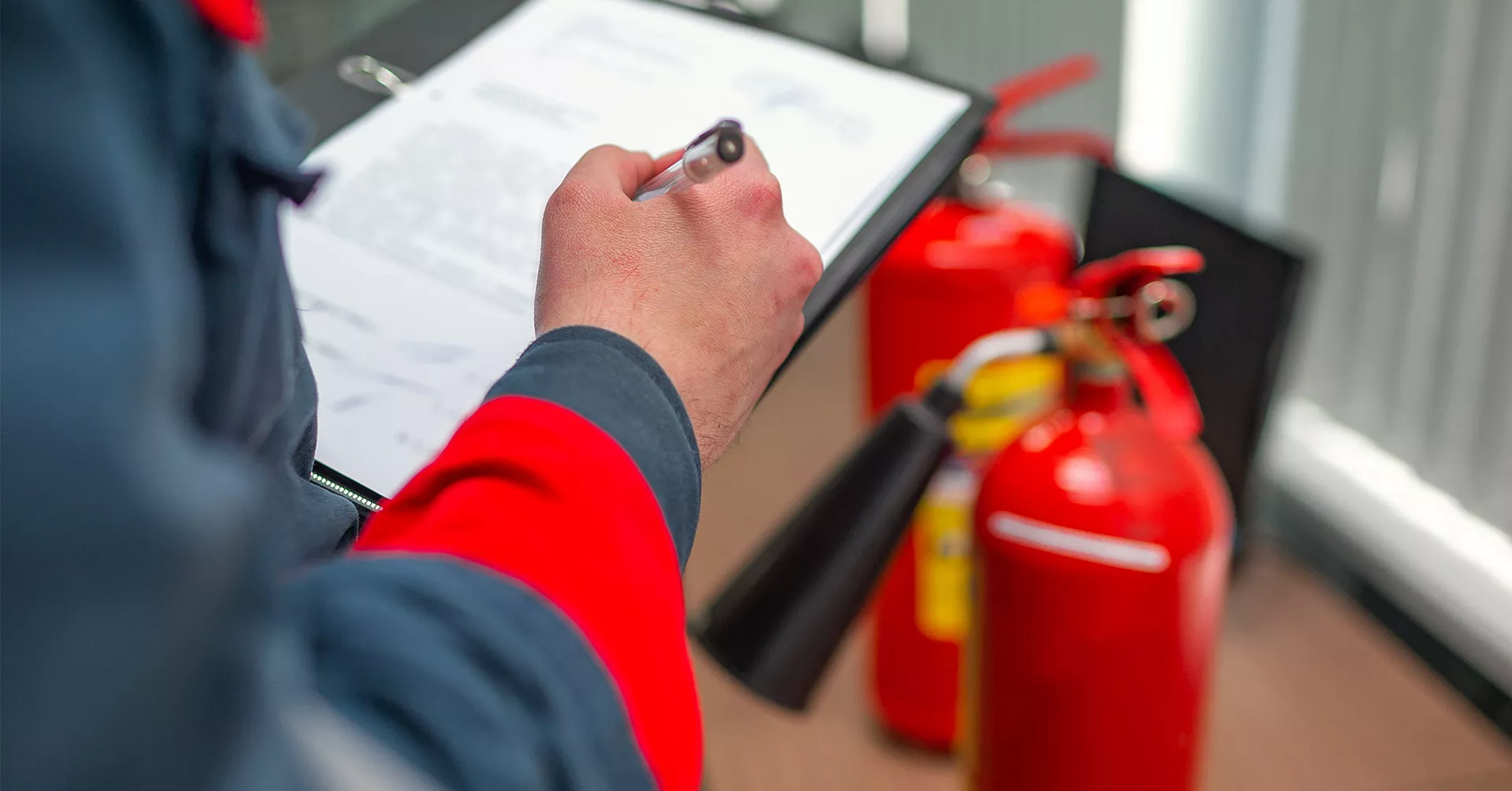![How to Create an Effective Workplace Safety Policy [+ Free Checklist]](https://www.alertmedia.com/wp-content/uploads/2022/02/Blog-HowTo-WorkplaceSafety-Policy-1024x536.jpg)
How to Create an Effective Workplace Safety Policy [+ Free Checklist]
Learn how to create a comprehensive workplace safety policy that can protect your people against workplace injuries and illnesses and keep your business running smoothly.

On-the-job injuries and illnesses are a fact of the workplace. For 2020, the Bureau of Labor Statistics reported 2.7 million nonfatal workplace injuries and illnesses logged by private industry employers—amounting to 2.7 cases per 100 full-time equivalent workers. Of those numbers, 2.1 million were injuries (down from 2.7 million in 2019). The number of total reported illness cases, however, grew by more than four times to 544,600, thanks in large part to COVID-19-related cases.
Employers are legally required by the federal Occupational Safety and Health Act (OSHA) to assure safe and healthful working conditions for employees. On top of that, many states have their own workplace safety laws and regulations regarding an employer’s duty of care for their employees.
Noncompliance with safety standards can lead to costly fines, greater liability for lawsuits, and could even land you on the National Council for Occupational Safety and Health (National COSH) “Dirty Dozen” list. For any organization concerned about employee health and safety—not to mention public image—this is one list you don’t want to be on.
While you may never completely eliminate injuries, accidents, or illnesses within a business setting, a majority of issues could be avoided with a workplace safety policy. For the ones that can’t be averted, formal guidelines will help reduce confusion and frustration for your employees and minimize disruptions for your business.
A comprehensive safety policy is one of the best ways to protect your people against workplace injuries and illnesses and ensure compliance with regulations. In this article, we’ll explore how a workplace safety policy will help your business and what your policy should include.
What Is a Workplace Safety Policy?
A workplace safety policy is a set of rules and procedures instructing employees on how to safely conduct themselves in work environments. The purpose of a workplace health and safety policy is to prevent illnesses, injuries, and fatalities that affect your people and your business. You can think of the policy as a playbook to help employees understand their roles and responsibilities when it comes to staying safe on the job.
While a workplace safety policy generally begins with an overarching, written document that establishes principles, objectives, and guidelines for maintaining a safe working environment, it doesn’t end there. Your company policy on health and safety should also include specific plans of action as well as tools for carrying out those plans. Depending on your particular organization, additional tools might include things like personal protective equipment (PPE), checklists of safety procedures, an emergency notification system, and mandatory safety training.
It isn’t just construction sites, hospitals, factories, or chemical plants that are exposed to occupational dangers—workplace safety applies to every industry and business type. For example, food service workers require guidance and training to avoid burns, cuts, lacerations, and fires. Any company with an office or storefront faces a heightened risk of an active shooter event. And all businesses are susceptible to the slips and falls that come along with inclement weather.
Why Create a Safety Policy?
Workplace safety guidelines set expectations and promote best practices. The guidelines you lay out will help employees know what is expected of them in certain situations. When one of your drivers is involved in an accident or an employee experiences second-degree burns, knowing how to respond is critical to minimizing the impact of the incident, be it physical, financial, or emotional pain and suffering.
If you’re like most employers, you’ve experienced a rising influx of questions since March 2020. “If I get COVID, how long until I can come back to work? What are the company policies on worker screening and facial coverings? What provisions is the business making to ensure safe distancing in the office?” Creating a workplace safety policy helps clear up questions like this and lets employees know what to expect when any type of health or safety matter arises.
Your policy also serves to clarify what will happen if employees don’t adhere to guidelines—whether that’s a warning, disciplinary action such as a suspension, or termination for repeat offenders.
Perhaps now more than ever, employees are scrutinizing the safety conditions of their current or potential workplace. From PPE, masks, and work-from-home programs to the company policy for handling harassment or abuse claims, employees want assurance that an organization takes worker health and safety seriously. A workplace safety policy builds trust with your employees that their worksites and equipment are free of safety hazards, there’s a first aid kit on site, and other signs that you’re looking out for their well-being.
What to Include in Your Workplace Safety Policy
There are several major components to a successful workplace safety policy. We’ll walk you through what they are and how you can accomplish them.
A safety statement

A major first step in establishing a workplace safety and health program is getting all employees to commit to the principle of workplace safety. To this end, your company should create and distribute an official statement outlining your company’s stance on workplace safety. A written statement reinforces safety as a core part of the company’s mission, values, and culture and serves as a guide to the daily actions of all employees. Your policy statement should include both the company’s overall ethos regarding safety as well as concrete goals, leaving no question that safety is a priority for the organization.
Safety guidelines
Announcing the importance of safety is one thing, but you then need to provide specifics of exactly what that means when the rubber meets the road. Clear and thorough guidelines will help your employees understand what is expected of them in a variety of situations.
You should list out guidelines for safety in your workplace that all employees can reference. The exact list will vary depending on your unique environment and the risks you face. However, consider the following ten work safety guidelines as a start:
- Always prioritize safety over speed. Never take shortcuts, and always follow the proper procedures.
- Report any safety concerns as soon as you notice them. Include how and to whom they should be reported, whether it’s human resources or a member of the safety committee.
- Ensure a clear and accessible route to emergency exits and equipment.
- Be alert and awake on the job, and pay attention to your work surroundings at all times.
- Wear all safety and personal protective equipment provided to you and as prescribed.
- Don’t operate machinery or perform dangerous tasks you have not been trained for. When in doubt, contact your supervisor or manager for instruction, guidance, or training.
- Be aware of and practice safe lifting techniques.
- Know and follow all emergency procedures and safety guidelines.
- Do not come to work under the influence of drugs or alcohol.
- Take breaks regularly—employees who are exhausted or overworked or more prone to accidents.
Reporting guidelines
OSHA has specific guidelines requiring employers to report fatalities and severe injuries within a specified timeframe. There are also new state and local requirements for reporting COVID-19 cases contracted by employees. Regulations aside, you don’t want a wounded employee sitting there wondering, “Should I call my boss first or call 911?” Defining clear procedures for reporting incidents helps employees act quickly and decisively, which in turn minimizes the severity of injuries and helps everyone in the organization bounce back as rapidly as possible.
Your safety policy should include a clear breakdown of how to report safety hazards, as well as injuries or illnesses. Workers should know exactly what types of incidents to report, to whom, and within what timeframe. If your company uses an emergency notification system, employees should know how and when to use it, so they can get important messages to the right people at the right time.
Checklists of safety procedures
A safety checklist is a tangible tool for helping employees practice ongoing safety procedures while giving managers an overview of important behaviors or potential hazards. A checklist helps employees remember the details of intricate or lengthy processes, creates accountability, and serves as a continued reminder to focus on safety.
Create simple, step-by-step checklists for any procedures you perform often. It might be a list of steps for cleaning and storing equipment, checking sidewalks and walkways for hazards, or a closing procedure for securing the worksite before employees leave. When creating your checklist(s), think about the types of accidents or injuries you are trying to prevent and, if necessary, look to past injuries and losses with an after action report to help guide you on what to include. You may also need to consider any regulations from OSHA or other agencies to make sure your procedures are compliant.
Specific sections for high-impact or frequent safety risks
Every business is unique—thus, every company’s safety plan will be a bit different. And a safety plan isn’t very useful if it fails to cover the issues most pertinent to your business. Before creating your plan, perform a risk assessment to identify common factors or trends. As a starting point, look through any records you have, including first-aid logs, past OSHA violations, worker’s compensation claims, and reports of all injuries, illnesses, or close calls.
Based on your risk assessment, you can include specific policies for high-risk events. For example, you may need to reinforce safety rules around the proper use of personal protective equipment such as harnesses, protective goggles, or gloves. If you have workers laboring on construction sites, you’d be well-served to include a specific policy about how to prevent falls. And for any organization affected by severe winter weather, you might want to include a policy about safe driving and how workers can protect themselves against cold weather threats like hypothermia and frostbite.
Workplace Safety Policy Examples
As important as it is to have a workplace safety policy, many businesses put off creating one simply because the task feels daunting or they’re not sure where to start. To help, we’ve included a few examples which you can use as a guide. While these samples are a great starting point, they should be expanded upon and tailored to your specific needs.
Policy sample #1: How to report a safety violation
This example from Workable, a world leader in recruiting software, covers key elements of an accident reporting policy, including:
- A list of specific incidents which employees are obliged to report
- Accident reporting procedures, including to whom, in what format, and the specific details needed
- Disciplinary consequences for failure to comply with the policy
Policy sample #2: COVID-19 plan
To help business owners who may be overwhelmed by new requirements related to COVID-19 response, OSHA has created a plan template that employers can customize to fit the needs of their workplace. This comprehensive, fillable template covers policies, procedures, and controls, including:
- Roles and responsibilities
- Hazard assessment and worker protections
- Personal protective equipment (PPE)
- Health screening and medical management
The Role of Communication in Workplace Safety
Once you’ve created the company’s workplace safety policy for your business, be sure to include it in the employee handbook and provide a copy to each employee. You’ll likely also want to communicate your policy as part of onboarding procedures and employee training.
There are a number of things that could threaten workplace safety—from unsafe practices to bad weather, a new disease or virus variant, or even civil unrest. When there’s no time to waste, emergency communication software ensures your teams can get urgent messages through to the right people via a variety of channels. Two-way messaging means your workers can not only ask for help, but they can also send important status updates as the situation unfolds. By using pre-built templates and a system with real-time delivery, you save precious time in situations when literally every second counts. This way, even off-site employees can communicate information about accidents, injuries, or any other type of safety emergency.
Conclusion
A safe workplace benefits everyone. It shields workers from harmful injuries and illnesses, reduces absenteeism and turnover, protects your equipment, and above all, promotes a productive and happy workforce. By putting a solid workplace safety plan in place now, versus after a perilous on-the-job incident, you’re taking a major step in looking after your people and improving your organization overall.



![Building a Safety Culture [Webinar Recap]](https://www.alertmedia.com/wp-content/uploads/2022/02/Blog-Webinar-Recap-BuildSafetyCulture.jpg)
